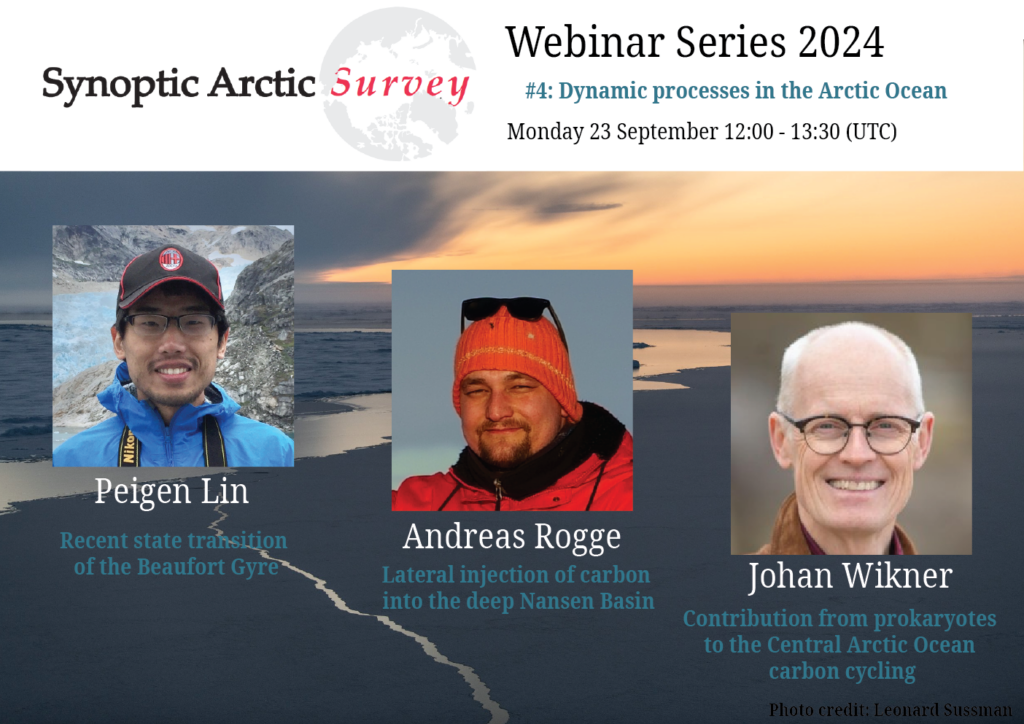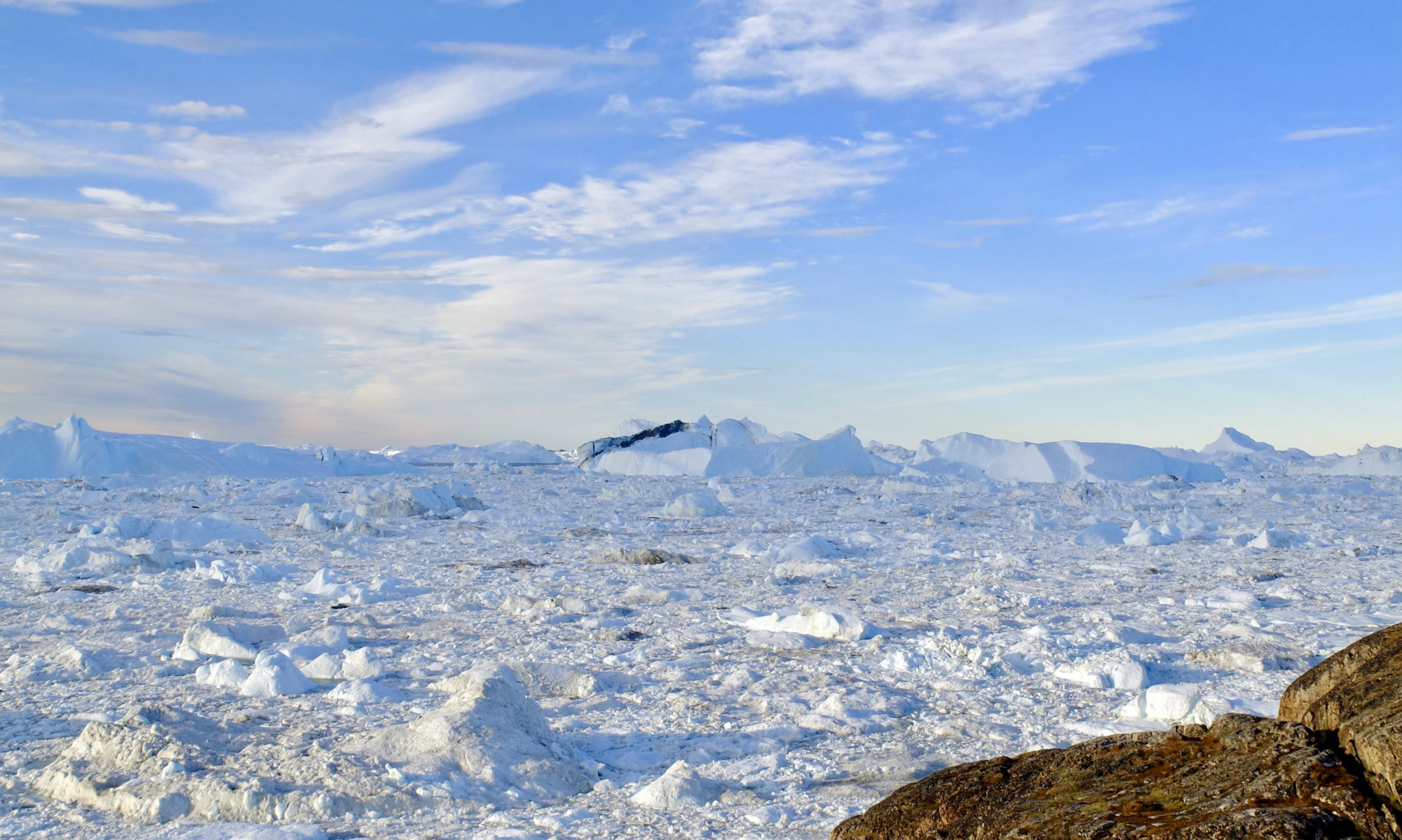Zoom webinar #4 2024 on Monday 23 September, 12:00 – 13:30 UTC

The Synoptic Arctic Survey (SAS) aims to map the present states and ongoing changes of the Arctic Ocean ecosystem, carbon cycle and associated hydrography. It does so by enhancing ongoing ocean monitoring with ship-based measurements.
This webinar showcases how ocean dynamics influences different processes of the Arctic Ocean. The circulation of water masses redistributes nutrients that provide the sustenance for the lower trophic levels of food webs in the marine ecosystem. It will be moderated by Øyvind Paasche, the chair of the SAS scientific steering committee, who will also give a brief introduction to the SAS initiative. There will be three solicited talks with room for questions and discussions:
-
- Peigen Lin – Associate professor at Shanghai Jiao Tong University, China
- Recent state transition of the Beaufort Gyre
- Andreas Rogge – Post doc. at Alfred Wegner Institute, Germany
- Dense shelf water propagation and subduction drives lateral injection of particulate organic carbon into the deep Nansen Basin
- Johan Wikner -Professor at Umeå University, Sweden
- Contribution from prokaryotes to the Central Arctic Ocean carbon cycling
- Peigen Lin – Associate professor at Shanghai Jiao Tong University, China
The webinar will take place in Zoom. If you would like to join the webinar, please register to receive the meeting link:
https://skjemaker.app.uib.no/view.php?id=17652163
Abstracts of the presentations in this webinar
Recent state transition of the Beaufort Gyre by Peigen Lin
The anti-cyclonic Beaufort Gyre is the dominant circulation of the Canada Basin and the largest freshwater reservoir in the Arctic Ocean. During the first part of the 2000s the gyre intensified, expanded, and accumulated freshwater. Using an extensive hydrographic dataset from 2003-2019, together with updated satellite dynamic ocean topography data, we find that over the past decade the Beaufort Gyre has transitioned to a quasi-stable state in which the increase in sea surface height of the gyre has slowed and the freshwater content has plateaued. In addition, the cold halocline layer, which isolates the warm/salty Atlantic water at depth, has thinned significantly due to less input of cold and salty water stemming from the Pacific Ocean and the Chukchi Sea shelf, together with greater entrainment of lighter water from the eastern Beaufort Sea. This recent transition of the Beaufort Gyre is associated with a southeastward shift in its location as a result of variation in the regional wind forcing. Our results imply that continued thinning of the cold halocline layer could modulate the present stable state, allowing for a freshwater release. This in turn could freshen the subpolar North Atlantic, impacting the Atlantic Meridional Overturning Circulation.
Further reading:
Recent state transition of the Arctic Ocean’s Beaufort Gyre | Nature Geoscience
Dense shelf water propagation and subduction drives lateral injection of particulate organic carbon into the deep Nansen Basin by Andreas Rogge
Polar dense waters fill the deepest parts of the ocean basins and drive the thermohaline circulation. They are primarily formed in the ice-free ocean surface as a result of increased heat loss and brine rejection during sea ice formation. While sinking to the ocean interior, those waters can carry large amounts of dissolved inorganic carbon to depth – a process known as solubility pump and one of the major sinks in the global carbon (C) cycle. In the northern Barents Sea, wind stress from land keeps large areas ice-free which intensifies dense water formation. These areas are also characterized by enhanced biological productivity due to increased light availability and nutrient supply from vertical mixing. Here I present evidence that this co-location of biological C fixation and dense water propagation, next to dissolved fractions, also cause an injection of particulate organic C from the Barents Sea shelf into the Nansen Basin. Using optical sensor and model data, I characterize this mechanism as a long-range transport of shelf-based carbon-rich material over thousands of kilometers, causing annual sequestration on Megaton level and filling a gap in the Arctic benthic C supply. Finally, I provide a glimpse into ongoing investigations in the central Arctic Ocean using also SAS data.
Further reading:
Contribution from prokaryotes to the Central Arctic Ocean carbon cycling by Johan Wikner
Prokaryotes encompass Bacteria and Archaea, two of the three domains in the taxonomic Tree of Life. They comprise the oldest and most numerous organisms on the planet, also having the most rapid growth rates (i.e., short generation times). Their biomass and associated production are therefore considerable despite their small size. Prokaryotes consequently have a profound impact on the cycling and flow of elements in the Ocean ecosystem. There is a paucity of studies of prokaryotic growth and respiration in the Central Arctic Ocean. During the SAS-Oden 2021 expedition Work Package 5 contributed with measurements of the biomass, growth and respiration rates of the prokaryotes in the Nansen, Amundsen and Makarov basins. In addition, gene expression and electron microscopy analyses are used to investigate activities and adaptations of prokaryotes during the cold and energy limited conditions. Preliminary results indicate extremely low biomasses, growth and respiration rates of the pelagic prokaryotes.

